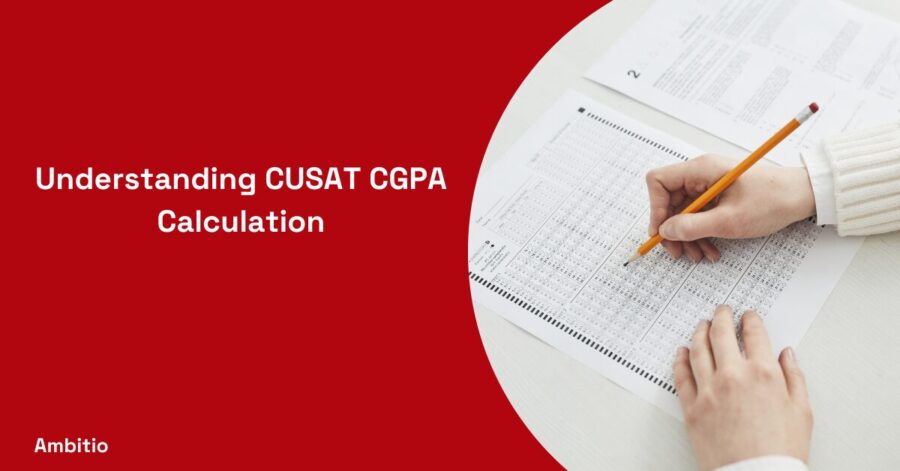12 December 2024
5 minutes read
Understanding CUSAT CGPA Calculation: Converting CGPA to Percentage

Introduction
Cochin University of Science and Technology (CUSAT) stands out as a premier educational institute, particularly known for its rigorous academic standards and evaluation methods.
For students navigating through their academic journey, understanding the CUSAT CGPA (Cumulative Grade Point Average) calculation is crucial. This comprehensive guide delves deep into the nuances of CUSAT’s CGPA system, its conversion to percentage, and the latest updates and tools available for students.
Demystifying the CUSAT CGPA System
The Fundamentals of CGPA Calculation at CUSAT
CUSAT employs a credit-based CGPA system to evaluate student performance. Each course is assigned a certain number of credits, reflecting its relative importance. Grades obtained in each course are converted to grade points.
For instance, an ‘A’ might correspond to a grade point of 10, while a ‘B’ might be a 9, and so forth. The CGPA is then calculated by multiplying the grade points by the course credits, summing these across all courses, and then dividing by the total number of credits.
The Role of Credits and Grades
Understanding the role of credits is essential in CGPA calculation. Credits assigned to a course signify the weightage of that course in the curriculum. A course with higher credits has a greater impact on the CGPA.
Similarly, grades reflect a student’s performance in each course. The higher the grade, the more grade points, and consequently, a higher CGPA.
Calculating Semester and Cumulative CGPA
The semester CGPA is calculated by considering courses undertaken in that particular semester. In contrast, the cumulative CGPA considers all completed courses throughout the student’s academic tenure. This cumulative average provides a holistic view of a student’s overall academic performance.
Converting CGPA to Percentage
One of the most common requirements for CUSAT students is to convert their CGPA into a percentage format. This conversion is often necessary for applications to higher education or employment where the percentage format is preferred.
Standard Conversion Formula
CUSAT provides a standard formula for this conversion, which is typically to multiply the CGPA with a factor (like 9.5) to get the equivalent percentage. However, it’s crucial to refer to the latest guidelines from the university as this factor can vary.
Importance of Accurate Conversion
Accurate conversion from CGPA to percentage is vital for maintaining consistency and fairness in evaluations. It ensures that students from CUSAT can effectively present their academic credentials in formats required by institutions or employers worldwide.
Navigating Through CUSAT’s Grading System
The grading system at CUSAT is comprehensive, catering to a diverse range of subjects and faculties. Each course has a designated grade point average (GPA), which feeds into the overall CGPA.
Understanding Grade Allocations
Grades in CUSAT are allocated based on a student’s performance in examinations, assignments, projects, and other academic activities. Each grade corresponds to a numerical value, which is then used in the CGPA calculation.
Variations Across Departments
Different departments may have slight variations in grading. For example, the grading in engineering might differ slightly from that in the science or humanities departments. It’s important for students to familiarize themselves with their specific departmental grading policies.
Latest Updates in CUSAT’s CGPA Calculation
CUSAT regularly updates its CGPA calculation methods and grading system. These updates may include changes in the credit allocation, grading scale, or the CGPA to percentage conversion formula.
Staying Informed About Changes
Students should regularly check official university communications, such as emails or the university website, for the latest updates. Understanding these changes is crucial for the accurate calculation of CGPA and its conversion to percentage.
Impact of Updates on Students
Changes in the CGPA calculation can significantly impact a student’s academic planning and performance assessment. It’s essential for students to adapt to these changes quickly to ensure their academic records accurately reflect their efforts and achievements.
Tools and Resources for Easy CGPA Calculation
To assist students in the CGPA calculation process, CUSAT provides various tools and resources. These include online calculators, mobile applications, and comprehensive guides.
Utilizing Online Calculators and Apps
CUSAT’s online calculators and mobile apps are user-friendly tools that allow students to input their grades and instantly calculate their CGPA and converted percentage. These tools are particularly useful for students who wish to regularly monitor their academic progress.
Accessing Guides and PDFs
The university also provides detailed guides and PDF documents that outline the rules and methods for CGPA calculation. These documents are invaluable resources for students seeking to understand the intricacies of the grading system.
Preparing for a Global Academic and Career Landscape
- Understand International Academic Standards: Familiarize yourself with the global academic grading systems, especially in countries where you might consider further education or employment. Knowing how your CUSAT CGPA aligns with these standards is crucial.
- Accurate CGPA to Percentage Conversion: Master the process of converting your CGPA to a percentage format. This conversion is vital since many international institutions and employers prefer or require percentage grades.
- Highlight Academic Achievements: When applying to global universities or multinational companies, emphasize your academic strengths. Use your CGPA and its percentage equivalent to showcase your proficiency in your field of study.
- Develop a Comprehensive Resume: Include your CGPA and its percentage conversion in your resume. Make sure to explain the grading scale of CUSAT if it’s not widely recognized internationally.
- Prepare for Standardized Tests: If planning for higher education abroad, prepare for standardized tests like the GRE, GMAT, or TOEFL, as they are often required and complement your CGPA.
- Gather Letters of Recommendation: Secure strong letters of recommendation from your professors. These letters should not only speak about your academic capabilities but also your potential for success in a global setting.
- Engage in Internships and Projects: Participate in internships, research projects, or any practical experience related to your field. This practical exposure, coupled with your academic record, makes a stronger case for your global readiness.
- Stay Informed About Global Trends: Keep abreast of the latest trends and developments in your field of study globally. This knowledge demonstrates your commitment and adaptability to a global academic and professional environment.
- Work on Language and Communication Skills: Proficiency in English or other relevant languages is essential. Enhance your language skills, as they are crucial for both academic success and professional communication in a global context.
- Network with Alumni and Professionals: Connect with CUSAT alumni or professionals working in the global arena. Their insights and advice can be invaluable in navigating international academic and career pathways.
- Explore Scholarships and Funding Opportunities: Research and apply for scholarships or funding opportunities available for international students. These can significantly support your academic journey abroad.
- Understand Cultural Differences: Be aware of cultural nuances and differences in the educational and professional settings of the country you’re aiming for. This cultural sensitivity is key to thriving in a global environment.
- Be Open to Diverse Opportunities: Be open to exploring diverse academic paths and career opportunities that may not directly align with your current field of study but offer global exposure and growth.
- Leverage Online Resources: Utilize online platforms for additional learning and certifications. Many reputable institutions offer free or paid courses that can complement your degree from CUSAT.
- Show Initiative and Leadership: Demonstrate initiative, leadership, and other soft skills in your academic and extracurricular activities. These qualities are highly valued in the global academic and professional spheres.
Conclusion
Understanding the CUSAT CGPA calculation and its conversion to percentage is a key aspect of a student’s academic journey. With the right tools, resources, and up-to-date information, students can navigate this process effectively, ensuring their academic achievements are accurately represented and recognized.
FAQs
What is the significance of credits in CUSAT’s CGPA calculation?
Credits determine the weightage of each course in the overall CGPA calculation. A higher credit course will have a greater impact on the CGPA.
How often does CUSAT update its CGPA calculation rules?
CUSAT periodically revises its calculation rules and grading system. It’s important for students to stay updated with the latest information.
Where can I find tools for calculating CGPA in CUSAT?
CUSAT provides online calculators, mobile apps, and PDF guides on its website to assist students in CGPA calculation.
Is it necessary to convert CGPA to a percentage?
Yes, converting CGPA to percentage is often required for higher studies applications or job applications where the percentage format is preferred.
How can I stay updated with the latest CGPA calculation rules at CUSAT?
Regularly check official university communications and the CUSAT website for the latest updates on CGPA calculation rules.

You can study at top universities worldwide!
Get expert tips and tricks to get into top universities with a free expert session.
Book Your Free 30-Minute Session Now! Book a call now




























